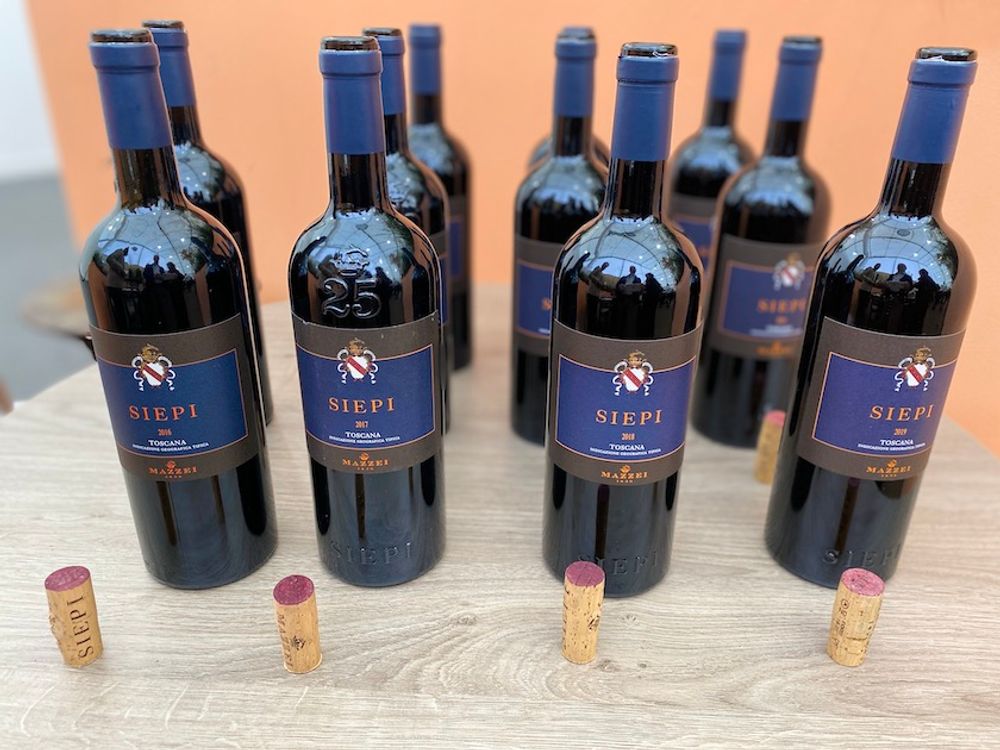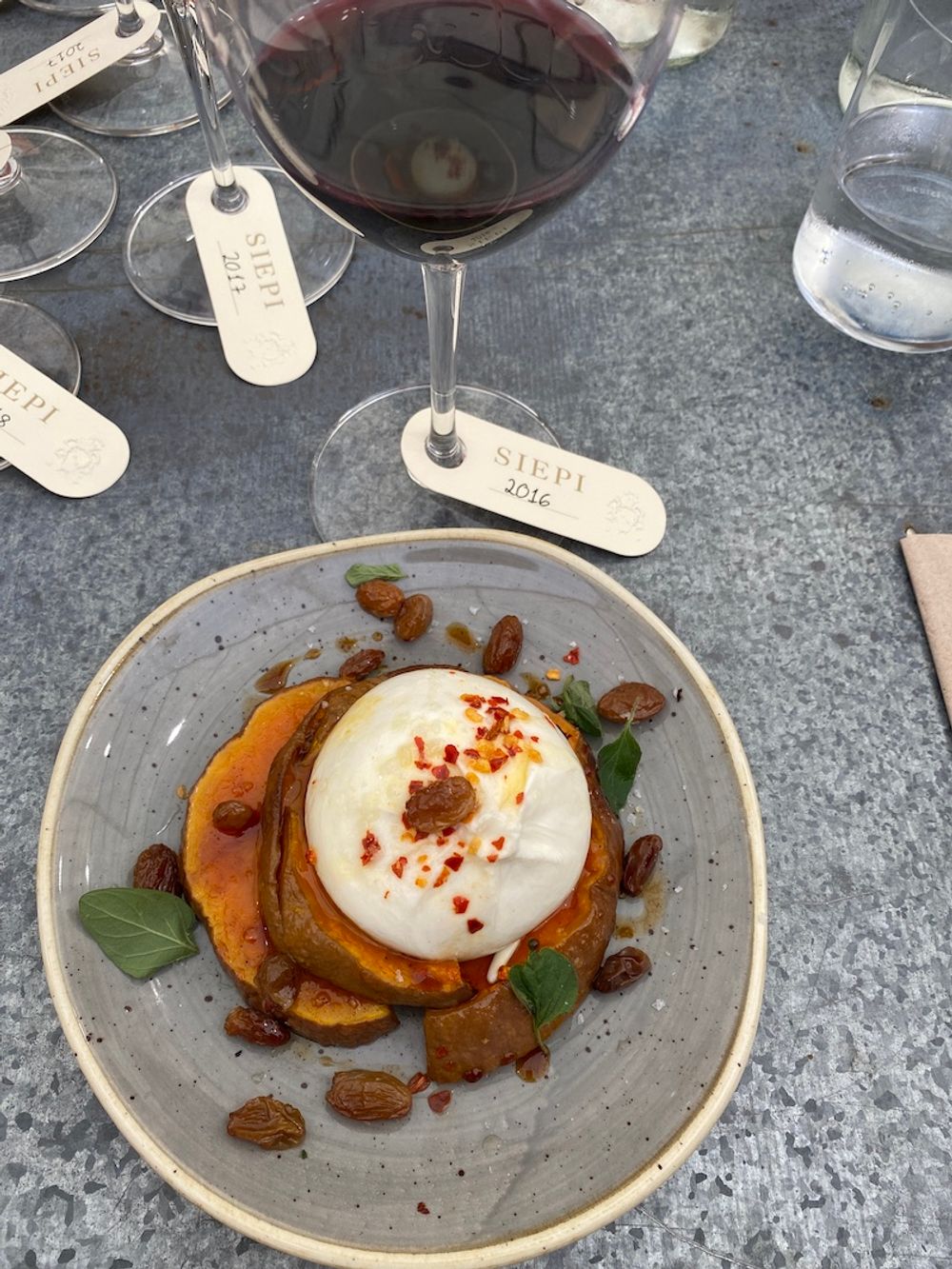“Where the Siepi 2018 has red and black fruit, the 2019 feels darker with cassis, currants, black cherry, coal and dark chocolate, there’s a floral lift too, some liquorice and dark plums,” writes Dean.
It is customary for Italian wine estates to have a bit of history but quite exceptional, as in the case of Mazzei, for winemaking to have carried on for 24 generations. Not only has this family been making wine for 600 years but one ancestor is deemed to be the first to have used the word “Chianti” as a denomination in 1398, while one ancestor, Filippo Mazzei, was a good friend of Thomas Jefferson in the Eighteenth Century, and is credited as first penning the doctrine ‘All men are created equal’ which found its way into the Declaration of Independence. Filippo was also a winemaker (and arms dealer) and was set up with land which became the first commercial vineyard in Virginia.

The tasting, Petersham Nurseries pop-up, Frieze art fair, London
Today, Mazzei makes wine across three estates, Zisola in Noto, Sicily, Belguardo in the Maremma region of Tuscany and Castello di Fonterutoli in Chianti Classico which is the first estate it inherited way back in the Eleventh Century. Siepi, which is the wine I have been invited to taste a vertical of, including the latest 2019 vintage, is one of nine wines produced at Castello di Fonterutoli and a wine that has been credited by Gambero Rosso as being one of the most influential wines in changing Italian wine style – a bold, structured red that is a wonderful marriage of Sangiovese and Merlot.
And talking of marriages, the tasting takes place for the new Siepi 2019 at a pop-up restaurant run by Petersham Nurseries at London’s Frieze art fair, the connection being that current generation Giovanni Mazzei, the company’s export director, is married to Lara Boglione the eldest daughter of Petersham owners Gael and Francesco Boglione. In 2003 Lara and Giovanni founded Italian wine merchant Petersham Cellar.

Siepi Toscana IGT is a 50/50 Sangiovese/ Merlot blend that was first made in 1992 but has been getting a lot of notice recently on account of the past five vintages that have simply been outstanding – the wine is getting better with greater finesse and elegance, although with the near-perfect scores it has been receiving there is not a lot of headroom on where it can go improvement-wise! Whether it’s the increasing age of the vines, the recently-added four months finishing in concrete, the strength of the vintages or simply greater skill who knows, but Siepi is getting better, make no mistake.
The vineyard responsible for the fruit is south-south-west facing at an elevation of 220-310 metres with the soil a mix of limestone marl and clay. The three plots in the vineyard total six hectares and are surrounded by woods which help with biodiversity and keeping the diurnal temperature range high, especially important during the hot Tuscan summers. Hand-harvested, gravity-fed, the wine is fermented in steel and then is aged in a mix of formats – the Merlot in small French barriques (70% new) and the Sangiovese in tonneaux (70% new). After bottling the wine is aged further before being sold at the Place de Bordeaux.
The four vintages of Siepi – 2016, 2017, 2018, 2019 – are tasted with and without food, are all of impressively high standard and are all different, with vintage variation.

Siepi 2019
For a new vintage the 2019 is so approachable, the nose slightly more closed than the other three vintages but with ripe, sandpaper-fine tannins and so much pure fruit to give and with such energy. Where the 2018 has red and black fruit, the 2019 feels darker with cassis, currants, black cherry, coal and dark chocolate, there’s a floral lift too, some liquorice and dark plums. Medium to full bodied, beautifully smooth, luxurious mouthfeel, layered, detailed and with an intense, dense structure and depth of flavour. The finish is dry and taut but it is still two or three years short of the start of its drinking window.
Siepi 2018
On the nose you find a mix of red and black fruit, mulberry, dried rosemary, milk chocolate – quite broody; on the palate the mouthfeel is beautifully rich and creamy with gorgeous, silky smooth tannins. Rich and sumptuous but never too much on account of the wine’s superb balance – the acidity and grip of the Sangiovese framing the seductive red and black fruit and chocolate. The wine has this fresh wash of blood orange juice that makes you want to have another mouthful, with a lovely little chocolate and hazelnut detail on the long finish. Stunning and, for me, the star of the tasting.
Siepi 2017
This Siepi is in remarkable shape given how difficult the vintage was (frost and water stress). The decision to let the Sangiovese hang and hope for rain was rewarded when 130mm fell in the last 20 days. If 2016 was more obviously Sangiovese taking the lead role in the wine, then this vintage was the turn of the Merlot. The wine is floral with much darker fruit, chocolate, iodine and tasting so fresh, pure and young. It is more one-dimensional a wine and does not have the palate breadth of the other wines, but still excellent and provides a nice contrast to the other vintages.
Siepi 2016
A truly outstanding vintage, with this wine now in an interesting space between evolution and still bearing the tannins of the year. This is more obviously Sangiovese taking a dominant role, a gorgeous lively, blood orange acidity keeping the wine a pointe, there are more savoury notes, some Christmas spice, wood, blackberry and red fruit. Drinking so well now and a superb match with the Petersham Nurseries lunch – particularly the first two courses of burrata with roasted pumpkin and ravioli with pumpkin butter and sage.

So, in conclusion, all four vintages were drinking superbly well, offering different facets of this remarkable terroir and blend. 2019 could possibly be the best vintage but on the day I would put the vintages in the following order: 2018, 2019, 2016 and 2017.
Siepi wines are imported and sold in the UK by Maisons Marques et Domaines.









































